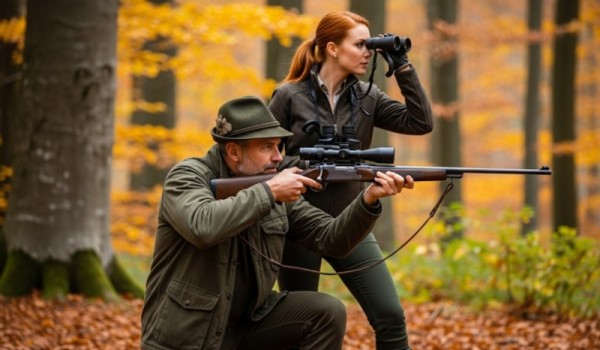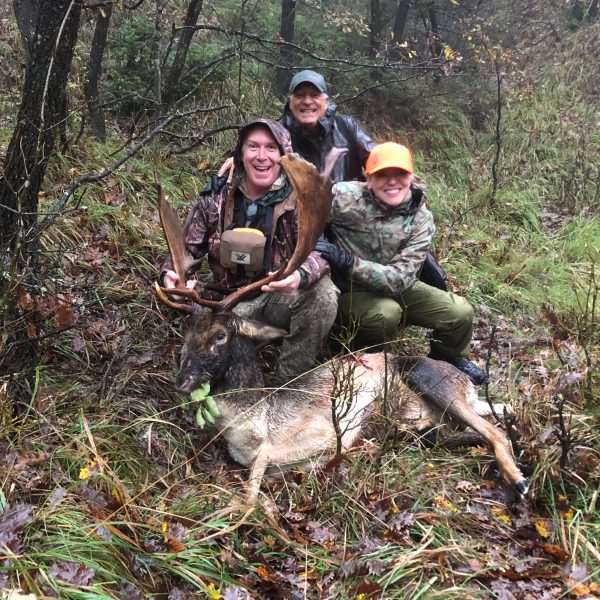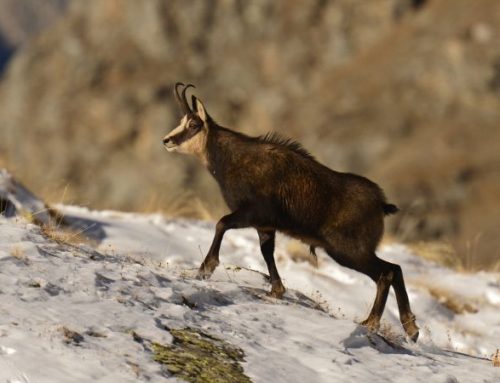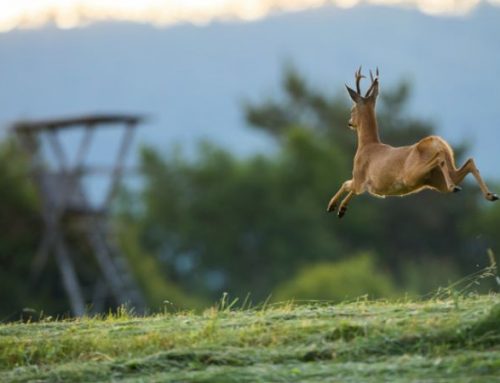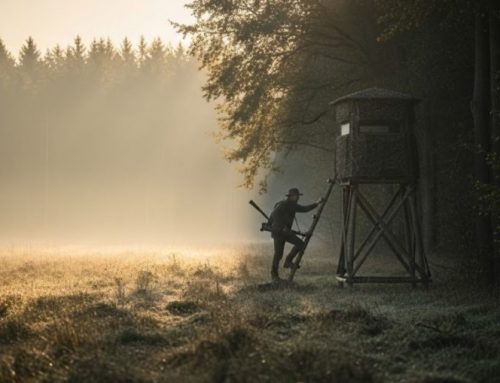Fallow Deer Rut Hunting: A Subtle but Clear Fracture Among Hunters
Some see it as a noble, fascinating, generous quarry… while others look at it with suspicion, if not outright dislike. The truth? As always, it lies somewhere in the middle.
The fallow deer is, in fact, an introduced species in our territory, even though its presence dates back centuries. And here’s where the first controversy arises: is it allochthonous or not? Legally, yes. But after five or six centuries of stable, adapted populations, one has to wonder if it still makes sense to consider it a “guest.” The land has claimed it; it lives there intelligently and has even carved out its own ecological niche in certain environments.
But not everything is peaceful: the fallow deer is in food competition with the roe deer, and this opens up another heated front in the debate. Fans of the “little woodland elf” see it as an intruder. Because when Dama dama settles into certain areas, it’s often the roe deer that gives way, moves on, or declines in number. And for those who live for the thrill of spotting the small, elusive roe deer in the first light of morning, that’s a blow to the heart.
But I — and I speak from experience, not theory — believe that hunting fallow deer deserves respect. It’s a quarry to understand, to read, to pursue with care. It’s never trivial. Its palmate antlers, so theatrical, are a source of great satisfaction, especially when you’re lucky enough to harvest a palancone, an adult male with a fully developed, massive, symmetrical rack — one that has survived several seasons and reached full maturity. These encounters are rarely by chance. And when they do happen, they leave a lasting impression.
Let’s also be honest: fallow deer meat is excellent. More abundant than roe deer, flavorful but delicate, with a high yield. Some people turn their noses up at it. But just one bite of a well-made fallow deer salami is enough to change their minds. Personally, in summer, I often serve daino tonnato — a cool, surprising dish — and when friends come over, I always make little breaded cutlets, fried quickly in butter and served as an appetizer: one leads to another, and they vanish in seconds.
Not everyone knows that fallow deer can also be hunted during the rut, a technique that captures the spirit — though not the sheer force — of red deer hunting. The fallow deer’s mating season is slightly later than the red deer’s. So while the “king of the forest” has already finished his roaring courtship, echoing powerfully through the valleys, the fallow deer takes the stage with his guttural call — rougher, less theatrical, but fascinating in its own way. You can hear it rumble low through the branches, especially on cool October days. And while it doesn’t reach the solemnity of the red deer, it offers a worthy conclusion to the season for those who love to pursue big game with a pounding heart and binoculars in hand.
Andrea and the Melanistic Palancone: A Hunt in Three Acts in the Ravines of Grondona
Some hunts slip into time. They don’t wrap up in an hour or end with a well-placed shot. They keep you on edge. They test you. They speak to you softly. Andrea’s story with the melanistic palancone of Grondona is one of those.
The first evening seemed promising. The sky had cleared after sunset, and the air was cooling fast. Andrea, armed with his trusty 6.5×55 SE bolt-action rifle, walked steadily through the forest alongside Luca, his guide. A young guy, but with the eyes of someone who’s seen many animals and learned to read them. Luca spoke little, but when he did, it was always to say the right thing. He’d point silently toward a direction, pause to listen, then move on like a shadow among the hornbeams.
That forest in the ravines, with its sudden cliffs and clearings that opened like whispers, was the perfect setting for the stalk. Suddenly, a roar. Deep, guttural. They stopped—hearts racing. Andrea looked at Luca, who nodded. The approach began. Fifty meters, thirty, maybe twenty. But then what every hunter fears happened: the wind shifted. And with it, everything changed. A sharp crack among the branches. Twigs snapping under mighty hooves. The roar died. The animal vanished.
That night, Andrea barely sleeps. It’s not so much the missed chance that weighs on him, but the fact he didn’t feel the wind shift in time. “Too much eagerness,” he keeps telling himself. Even Luca, calm as ever and patient to a fault, had pointed it out with a half-smile. “We’ll make up for it tomorrow.”
The next morning, they’re already in the hunting tower at dawn. The air is tense, still heavy with the disappointment of the night before. The forest wakes slowly. In front of them, among low rows of shrubs and hazels, pass four does and a young young buck. Andrea watches them respectfully. Beautiful, but not the reason he’s here. After a good hour, they descend and set off on foot again. Always stalking. But this time the wind comes from the sea — a light but annoying breeze that unsettles the balance of the forest. The roar is still heard, but distant, muffled. After wandering back and forth through beeches and brambles, they decide to head back.
That evening, everything changes. The air is stiller, the forest seems to hold its breath. Andrea and Luca move silently among the hornbeams and ancient acacias. Twice they try to approach on different calls. The first time, something moves in the underbrush and the animal beats them to it. The second, a wrong move betrays their presence. But it’s on the third attempt that everything falls into place.
A powerful grunt echoes among the low palanchi, in that area where the terrain drops sharply through rocks and ferns. Luca gestures with his eyes toward a small ridge. Andrea follows, feeling each step like a drumbeat in his chest. They reach a spot where the vegetation opens just slightly. The melanistic palancone is there. Motionless. Majestic. Its dark coat nearly blends it into the twilight, its broad, open antlers like maple branches raised to the sky.
Andrea kneels, steadies his breath, places his finger on the trigger. The shot shatters the silence like thunder, followed by a brief flight — then silence again. Luca says nothing. He simply places a hand on Andrea’s shoulder. A simple gesture. But full of meaning. In that silent embrace, there is everything.
Then comes the verification, the slow, respectful approach. The palancone lies there, resting on a bed of leaves. A silent, moving beauty. A trophy and a memory that will last forever.
Andrea crouches beside the animal, while Luca watches in silence. Only after a few minutes does he speak: “An animal like that, you come across only once in a while. You did well to wait.” Andrea nods. And deep down, he knows that shot wasn’t just an ending — it was the beginning of something.
Weidmannsheil!
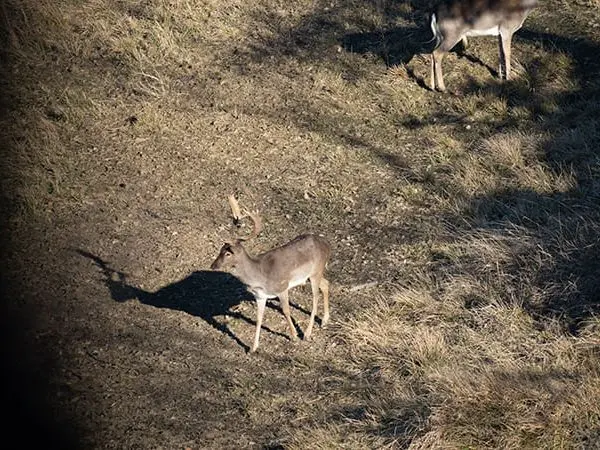
FAQ – How to Approach a Mature Fallow Buck During the Rut
How can I tell if the braying is from a mature buck or just a spike or young male?
You need a good ear — and some patience. Young males tend to have a higher-pitched, irregular, sometimes even choked-sounding bray. A mature palancone (dominant adult male) has a deeper, steadier, rhythmic call, especially when he’s calm. Like a drum echoing from the throat of the forest. And if you hear him confidently answering other males, you may be onto something.
Is it better to set up an ambush or go stalking?
It depends on the terrain and how active the group is. If the males are moving a lot — maybe due to high competition — stalking is more thrilling. But if you hear them staying put in a specific area, maybe near a clearing or an old field, it’s worth setting up there and waiting for him to move. The key is not to push too hard. Disturb him too much, and he’ll move to another valley.
How close can I get?
As close as possible — without being heard. A mature buck is alert, but when he’s in full braying mode, his senses may be slightly dulled by the competition and adrenaline. Still, don’t count on it. The wind is your worst enemy. Get it wrong once, and you’ll remember it for the next year.
What time of day do they bray the most?
Mostly at dawn and dusk, but on the right days, even in broad daylight. Strong males, especially in cool weather and during peak rut, will bray at midday. It takes patience… and a bit of luck.
What should I pack in my backpack?
Not much. Keep it light. Water, binoculars, a rangefinder, a pocketknife, a snack or two, and thin gloves. If you’ll be out long, add a waterproof shell or thermal layer. Don’t forget a rope or tarp if you’re hoping to carry the animal. Better to hope and be ready than get caught off guard.
What does “palancone” mean?
It refers to a mature, dominant male with broad, fully developed antlers — the palmate section wider than 5 cm. It’s not just about trophy size, but respect: harvesting a palancone means you’ve allowed a strong animal to grow, dominate, and contribute to the natural selection of the herd. It’s a decision to be made consciously, not out of vanity.
What gear is essential for rut hunting?
You don’t need much, but it has to be right. Clear binoculars, a reliable rangefinder, a compact and quiet backpack. Always carry a light poncho in case the weather shifts, and a headlamp for the walk back. And bring a rope if you plan to bring the animal back with the respect it deserves.
What should I wear?
Keep it simple. I prefer greens and browns over camo prints — what matters most is silence. No rustling fabrics. Go for soft materials: fleece or lightweight wool. A cap for sun, light gloves for moisture. And solid boots: in the woods at night, when tracking, your feet will want something they can trust.
What firearm is recommended?
A bolt-action rifle is perfect, especially if you’re patient and precise. Optics should be bright, with a sharp reticle and mid-range magnification. Braying hunts don’t usually require long-distance shots — if you move well, you’ll get close. But you’ll need to see and aim in the dark woods, so good lenses are worth the extra weight.
And what caliber?
Classic calibers work great: from .243 to 7×64, or .308 Win, 6.5×55 SE, even .30-06 with heavier bullets. Fallow deer aren’t armor-plated, but they’re not fragile either. You need a bullet that gets in, does its job, and preserves the meat. Better to drop him clean than chase a wounded animal.
A Little Digression: And After… You Cook
Once the hunt ends, another noble chapter begins: the kitchen. Fallow deer meat is lean, tender, and has a refined yet bold flavor. Those who’ve tasted a proper fallow deer salami know what I’m talking about.
One dish that’s perfect for summer? Daino tonnato — a chilled, elegant twist on the classic vitello tonnato. Absolutely worth a spot on your table.
Hunter’s-Style Fallow Deer Tonnato
Ingredients:
-
800g fallow deer topside (cleaned and well-trimmed)
-
2 carrots
-
2 shallots
-
1 celery stalk
-
1 bay leaf
-
5 peppercorns
-
Coarse salt
-
Extra virgin olive oil (as needed)
For the sauce:
-
2 hard-boiled eggs
-
1 small can of tuna in oil
-
1 tbsp salted capers
-
3 anchovy fillets
-
Extra virgin olive oil (as needed)
-
A splash of vinegar or lemon juice, to taste
Method:
Start by searing the meat in a very hot non-stick pan with a drizzle of olive oil and a small knob of butter. This creates the Maillard reaction, caramelizing the sugars on the surface for that perfect crust.
In the meantime, bring a pot of water to the boil with coarse salt, carrot, celery, shallot, and aromatics. Once boiling, lower in the meat and simmer gently for 45–50 minutes. Then turn off the heat and let the meat cool completely in its own broth.
While it cools, make the sauce: blend the egg yolks, drained tuna, desalted capers, anchovies, and just enough oil and broth to get a smooth, velvety cream.
(Some add a spoonful of mayonnaise — purists will say that’s heresy… but personally, I like it.)
Once the meat is cold, slice it thinly and lay it on a serving plate. Spoon the sauce over the top, garnish with a few whole capers and a drizzle of good olive oil.
Let it rest in the fridge for a couple of hours before serving.
Serve with a dry, chilled white wine — though a light, young red can work too. And if you’ve got some toasted rustic bread on the side… it’ll vanish in minutes.
Absolutely, the fallow deer deserves all this attention.
It may not be the king of the forest like the red deer, but it’s an animal that wins you over in silence, step by step.
It has elegance, presence, character. It forces you to slow down, to listen, to truly observe.
And when you see it there, motionless in the shadows, with those antlers that look like they were carved by wind and time, you realize that you don’t need a title to be noble. You just need to be.

